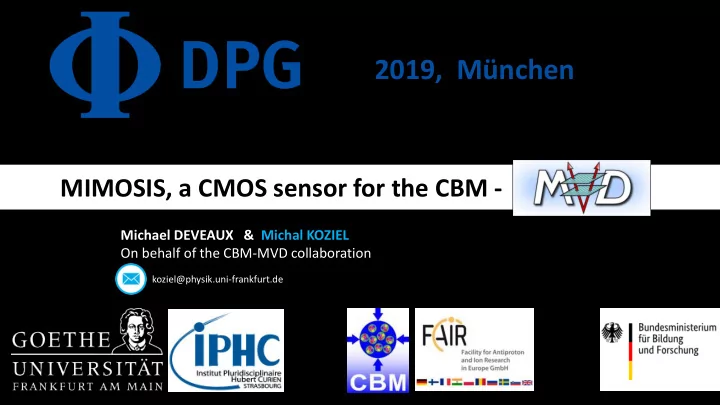

2019, München MIMOSIS, a CMOS sensor for the CBM - Michael DEVEAUX & Michal KOZIEL On behalf of the CBM-MVD collaboration koziel@physik.uni-frankfurt.de
Outline • The CBM-Micro Vertex Detector: reminder • Why another CMOS Pixel Sensor ? • MIMOSIS-0 – Sensor architecture – Test setup – Test results – Radiation tolerance • Summary 2
The CBM-MVD: reminder SIS100 setup # # 3 # CBM-MVD : # 2 1 0 - Improve secondary vertex resolution (open charm) - Tracking, focus low momentum particles - Background rejection in di-electron measurements R/O Heat sink The MVD hosts highly granular silicon pixel sensors featuring low material budget, fast read-out, excellent spatial resolution and robustness to radiation environment. 3
Delta=electron dominated MIMOSIS CPS development Sensor #2. 1 st MVD station CBM-MVD 1 st station ALICE-ITS (IB) AuAu 10 AGeV Radiation load TID ~270 krad 3 Mrad ~1.7x10 12 n eq /cm 2 3x10 13 n eq /cm 2 Radiation load NIEL There is no ready 50 mW/cm 2 <300 mW/cm 2 Power dissipation technical solution -10 C Operating temp. T ROOM ~1.25x10 4 /mm 2 /s 7x10 5 /mm 2 /s (x56 more than ITS) Peak hit rate Trigger Yes no Road map towards MIMOSIS: Today Small size pixel array -> MIMOSIS-0 Aims at selecting an optimum in-pixel architecture (AC vs. DC coupled pixels, performance of in-pixel amplifier and comparator) and studying the built-in priority encoder. 1st full-size prototype - submission 2019 2nd full-size prototype - submission 2020 MIMOSIS - submission 2021 4 The CBM-MVD sensor will be based on the ALPIDE asynchronous read-out but with entirely new digital circuitry (signal processing and transmission, slow control) and different in-pixel architecture.
1 st prototype => MIMOSIS-0 sensor Aims at selecting an optimum in-pixel architecture (AC vs. DC coupled pixels, performance of in-pixel amplifier and comparator) and studying the built-in priority encoder. 14.3 mm DC pixels AC pixels 2 mm Pixel size: 26.88 x 30.24 m • • 13 8-bit DACs EPI type / thickness: HR / 18 m • • 16 col x 54 rows => 16128 pixels 5
Properties of the amplification chain • The amplifier is found linear in a range between roughly 150 e and 600 e . Below this value, the gain is reduced, which complicates choosing substantially lower thresholds independently of the noise. • Above 600 e , the amplifier is intentionally saturated in order restrict the pulse duration. We assume the capacity of the charge injection system to 6 injection amouts precisely its nominal value of C = 160 aF
Properties of the amplification chain • • Time walk (variation of the delay as function of the signal The precise values vary by few 100 ns amplitude) of ∼ 1.4 µs and a jitter of 0.85 µs, observed for depending on the individual pixel and depend the minimum charge injected. on the detailed settings of the eight current and voltage sources, which steer the pixels. • Still modest signal of > 300 e ENC => the time resolution • might already be as good as 0.6 µs, …and may allow for Due to space constraints, all pixels share further frame time reduction for limited occupancies. common voltage sources => an individual 7 tuning of the pixels is not feasible.
Sensitivity to radioactive source Charge > 800 e • In many cases, the 1640 e generated by the photon exceed the saturation limit of the pixel. • Number of entries with low signal charge related to hits occurring far from the Charge < 150 e collection diode. Tests with 55-Fe source DC pixels AC pixels AC pixels DC pixels 8
Radiation tolerance studies • X-Ray tube used thanks to KIT Karlsruhe • Tolerance to ionizing radiation addressed • Focus: internal DACs in-pixel circuitry T ROOM 1600 1500 Fixed Patter Noise [e ENC] 1400 Response of the 1300 DAC output voltage [mV] 1200 internal DAC 1100 1000 900 800 700 600 500 400 Not irradiated 300 1 Mrad (fast irrad.) 200 3 Mrad (fast irrad.) 10 Mrad (+ 3h room temp) 100 0 0 20 40 60 80 100 120 140 160 180 200 220 240 260 DAC setting [ADU] Radiation dose [Mrad] 9
Summary and outlook • CMOS Pixel Sensor for CBM Micro Vertex Detector is being developed • The 1 st prototype shown a successful integration of • Pixels hosting AC and DC coupled preamplifiers • Priority encoder • Slow control units • The pulse shapes and lengths => it is conceptually suited to reach a ∼ 1 µs time resolution (ambitioned 5 µs) in combination with a dead time of ∼ 10 µs. Digital part to be adapted/tested. • MIMOSIS-0 is currently being tested for its radiation tolerance • Preliminarily results have been presented • To do: Leakage current measurements The FPN and thermal noise will be studied in detail AC vs. DC pixel ? => which pixel type for the upcoming submission • First reticle size prototype is being prepared for a submission - mid 2019. 10
Recommend
More recommend